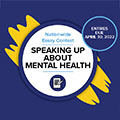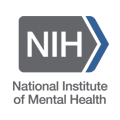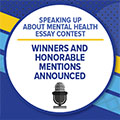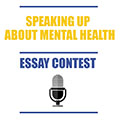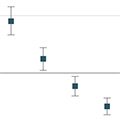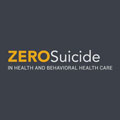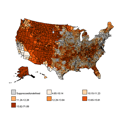Science Updates About Suicide
- Predictive Models Show Promise in Preventing Suicide
-
In a study funded by the National Institutes of Health, researchers created new suicide risk prediction models using data in electronic health records from the Indian Health Service.
- Primary Care Can Play Key Role in Suicide Prevention
-
Adding suicide care practices to routine adult primary care visits reduced suicide attempts by 25% in the months after the visit.
- Increases Found in Preteen Suicide Rate
-
Researchers at the National Institutes of Health (NIH) found that rates of preteen suicide (ages 8-12) have been increasing by approximately 8% annually since 2008.
- Saving Lives Through the Science of Suicide Prevention
-
• 75th Anniversary
Evidence-based efforts to improve suicide risk screening, assessment, and intervention are helping to save lives, thanks to research supported by NIMH.
- Emergency Department Intervention Reduces Adult Suicide Risk
-
Evidence-based practices for suicide prevention effectively reduced suicidal behaviors among adults seen for care in emergency departments.
- Youth Emergency Department Visits for Mental Health Increased During Pandemic
-
Hospital visits for urgent mental health care increased among children and teens in the second year of the COVID-19 pandemic, according to an NIMH-supported study.
- Youth Suicide Rates Increased During the COVID-19 Pandemic
-
In one of the first studies to examine national youth suicide rates during the COVID-19 pandemic, researchers showed that the pandemic increased youth suicide rates and the impact varied by sex, age, and race and ethnicity.
- Family-Based Intervention Lowers Long-Term Suicide Risk in Youth
-
In a recent study supported by the National Institute of Mental Health, researchers examined the impact of a family-based intervention on suicide risk in youth and found risk-reduction benefits up to 10 years later.
- NIH Announces Winners of High School Mental Health Essay Contest
-
The National Institutes of Health (NIH) is pleased to announce the winners of 2022 Speaking Up About Mental Health! This Is My Story essay contest.
- A Clinical Pathway for Suicide Risk Screening in Adult Primary Care
-
An NIMH-supported workgroup developed an evidence-based screening pathway to help primary care doctors identify adults at risk of suicide and bridge them to critical mental health services.
- Study Shows REACH VET Program Effective for Veterans at High Risk for Suicide
-
A recent NIMH co-authored study shows that a Department of Veterans Affairs suicide prevention program was associated with fewer inpatient mental health admissions and emergency department visits, and a 5 percent reduction in documented suicide attempts.
- Mindful Mood Balance Effective for Treating Residual Depressive Symptoms and Suicidal Ideation
-
NIMH-supported researchers have found an online mindfulness-based cognitive behavioral therapy—called Mindful Mood Balance—is effective at reducing residual depressive symptoms and at reducing suicidal ideation in those who experience these symptoms.
- National Contest Encourages High School Students to Write Short Essays Exploring Mental Health
-
The National Institutes of Health invites students ages 16 to 18 years old to participate in the “2022 Speaking Up About Mental Health!” essay contest.
- Understanding the Characteristics of Suicide in Young Children
-
Researchers supported by NIMH recently published a study describing the characteristics of suicide in young children and the factors that sometimes precede these tragic events, providing an avenue for future research and intervention.
- Researchers Find Disparities in Suicide Risk Among Lesbian, Gay, and Bisexual Adults
-
Suicide risk among lesbian, gay, and bisexual adults varies considerably depending on the intersection between sexual identity and other aspects of identity, such as gender, age, and race/ethnicity, according to a study led by NIMH researchers.
- A New Strength-Focused Framework to Prevent American Indian and Alaska Native Youth Suicide
-
Researchers have developed a promising new framework for suicide prevention in American Indian and Alaska Native (AI/AN) communities. The research framework expands on conventional risk reduction strategies by placing Indigenous culture, knowledge, beliefs, and community collaboration at the center of the approach.
- Improved Emotion Regulation in Dialectical Behavior Therapy Reduces Suicide Risk in Youth
-
An analysis of clinical trial data shows that improvements in emotion regulation in youth at high risk for suicide who received dialectical behavior therapy (DBT) led to a reduction in self-harm behaviors.
- Assessing Suicide Risk Among Childbearing Women in the U.S. Before and After Giving Birth
-
NIMH-supported researchers investigated suicide risk among women in the year before and year after giving birth.
- Investigating Unintentional Injury as a Risk Factor for Self-Harm
-
In a recent study, NIMH-supported researchers found that certain types of unintentional injury have stronger associations with self-harm than others in adolescents.
- Adaptive Screener May Help Identify Youth at Risk of Suicide
-
In a study supported by NIMH, researchers have developed a computerized adaptive screener that can help identify youth at risk for attempting suicide.
- NIMH Awards Funding for Research on Preventing Firearm Injury and Mortality
-
Suicide attempts by firearm are especially dangerous, with as many as 9 out of 10 attempts resulting in death. NIMH is supporting three projects focused on preventing and reducing firearm injury and mortality to help address the critical need for more research in this area.
- Brief Suicide Prevention Interventions in Acute Care Settings May Reduce Subsequent Suicide Attempts
-
A research project supported by NIMH analyzed multiple studies to determine the effectiveness of brief suicide prevention interventions in acute care settings.
- Media Advisory: NIMH Researchers Available to Discuss Suicide Prevention
-
Experts from the National Institute of Mental Health are available to speak on topics related to suicide and suicide prevention, including the warning signs of suicide, suicide prevention methods, trends in suicide rates, how to find mental health help and support, and the latest in suicide prevention research.
- NIMH Leadership Describes Suicide Prevention Research Priorities
-
In a new paper, published in JAMA Psychiatry, NIMH looks forward, outlining the next stages in the Institute’s suicide prevention research priorities.
- Emergency Drug Overdose Visits Associated with Increased Risk for Later Suicide
-
A new data analysis has found patients who visited the emergency department for an opioid or sedative/hypnotic drug overdose were at higher risk of dying by drug overdose or suicide in the year after being discharged relative to the general population.
- Developing Rapid, Accurate Assessment of Mental Disorders, Suicide Risk in Youth
-
For many adults who have a mental disorder, symptoms were present—but often not recognized or addressed—in childhood and adolescence. Early treatment can help prevent more severe, lasting impairment or disability as a child grows up.
- Emergency Department Study Reveals Patterns of Patients at Increased Risk for Suicide
-
A new NIMH-funded study found that people who presented to California emergency departments with deliberate self-harm or suicidal ideation had suicide rates significantly higher than those of demographically similar Californians in the year after discharge.
- NIH Announces Winners of High School Mental Health Essay Contest
-
NIH announces 10 winners of the “Speaking Up About Mental Health! This Is My Story” national essay challenge, aimed at spurring conversations among youth about mental health and encouraging them to seek support for themselves and others.
- Crisis and Suicide Prevention Services Struggle with Demand after Celebrity Suicides
-
The United States may lack the resources needed to meet increases in demand for suicide prevention services that occur after celebrity suicides, according to a recent study of crisis mental health services published in the journal Psychiatric Services.
- Release of “13 Reasons Why” Associated with Increase in Youth Suicide Rates
-
A study conducted by researchers at several universities, hospitals, and the National Institute of Mental Health (NIMH) found that the Netflix show “13 Reasons Why” was associated with a 28.9% increase in suicide rates among U.S. youth ages 10-17 in the month (April 2017) following the shows release, after accounting for ongoing trends in suicide rates.
- Nationwide Essay Contest Challenges High Schoolers to be Frank About Mental Health
-
The National Institutes of Health invites students ages 16 to 18 years old to participate in the “Speaking Up About Mental Health!” essay contest to explore ways to address the stigma and social barriers that adolescents from racial and ethnic minority populations may face when seeking mental health treatment.
- Suicide: How You Can Make a Difference
-
The recent deaths of two school shooting survivors has brought the topic of suicide into everyday conversations. It’s important to know some facts and to know what to do if you think someone might be at risk for self-harm.
- NIH Study Shows Many Preteens Screen Positive for Suicide Risk During ER Visits
-
A research team found nearly one-third of youth ages 10 to 12 years screened positive for suicide risk in emergency department settings, including those seeking help for physical concerns only.
- New Pathways for Implementing Universal Suicide Risk Screening in Healthcare Settings
-
A new report provides guidance on how to implement universal suicide risk screening of youth in medical settings. The report describes a way for hospitals to address the rising suicide rate in a way that is flexible and mindful of limited resources.
- NIMH Addresses Strategies for Suicide Prevention in Live Event
-
During NIMH’s Facebook Live event held in recognition of Suicide Prevention Week, NIMH Director Dr. Joshua Gordon and Dr. Jane Pearson, chair of the Suicide Research Consortium in NIMH’s Division of Services and Intervention Research, discussed some of the most recent suicide prevention research findings from NIMH, warning signs, and prevention strategies.
- NIH Directors Address Chronic Pain and Opioid Crisis at Annual Society for Neuroscience Meeting
-
On Tuesday, Nov. 6, 2018, at a press conference at the Society for Neuroscience’s annual Meeting, National Institutes of Health directors will discuss how NIH is marshalling resources, primarily through the HEAL (Helping to End Addiction Long-term) Initiative, to come up with short- and long-term solutions for countering the pain and opioid crisis.
- Media Advisory: NIMH Researchers Available to Discuss the Suicide Prevention Research
-
For National Suicide Prevention Awareness Month, NIMH Director Dr. Joshua Gordon and Dr. Jane Pearson, chair of the Suicide Research Consortium at the NIMH, are available for interviews on suicide prevention research, trends, and the findings and implications of recent studies.
- New Toolkit Offers Ways to Evaluate Suicide Prevention Efforts in Arctic Communities
-
The National Institute of Mental Health (NIMH), in collaboration with the Mental Health Innovation Network and other federal partners, has released the RISING SUN toolkit to help clinicians, communities, policymakers, and researchers measure the impact and effectiveness of suicide prevention efforts in rural and tribal communities.
- Predicting Suicide Attempts and Suicide Deaths Using Electronic Health Records
-
Researchers have developed a new prediction model that substantially outperforms existing self-report tools used to predict an individual’s risk of a suicide attempt or dying by suicide.
- Therapy Reduces Risk in Suicidal Youth
-
A recent clinical trial of a psychotherapy called dialectical behavior therapy (DBT)—which has been shown to be effective in reducing suicide-related behavior in adults—showed that DBT can also reduce suicide attempts and suicidal behavior in adolescents.
- Suicide: How You Can Make a Difference
-
The recent deaths of Kate Spade and Anthony Bourdain have brought the topic of suicide into everyday conversations. It’s important to know some facts and to know what to do if you think someone might be at risk for self-harm.
- Age-Related Racial Disparity in Suicide Rates Among U.S. Youth
-
Researchers have discovered an age-related racial disparity in suicide rates for U.S. youth between the ages of 5 and 17. The findings suggest a need for more research into contributing factors and targeted interventions for children.
- Hubs Help Native American Communities Address Youth Suicide
-
Three NIMH-funded collaborative research hubs are exploring the factors behind the high suicide rates among American Indian (AI) and Alaska Native (AN) youth and designing and testing approaches to preventing suicide.
- Intramural Researchers Develop Suicide Risk Screening Toolkit for Medical Settings
-
NIMH researchers have developed a brief screening questionnaire for medical professionals to identify youth at risk for suicide.
- Life-Saving Post-ER Suicide Prevention Strategies are Cost Effective
-
Three interventions designed for follow up of patients who are identified with suicide risk in hospital emergency departments save lives and are cost effective relative to usual care.
- Emergency Departments Could Play Significant Role in Reducing Suicide Attempts
-
Research funded by the National Institute of Mental Health (NIMH) shows hospital emergency departments can play a vital role in lowering the number of suicide attempts among adults by as much as 30 percent.
- NIMH Funds 3 ‘Zero Suicide’ Grants
-
NIMH is supporting Zero Suicide efforts with 3 new research grants. Each project focuses on prevention and health care systems.
- Coping With Familial Mental Illness in Stressful Times
-
“An NIH/NIMH lifer” reveals how his Asian American family successfully coped with severe mental illness compounded by discrimination.
- Twitter Chat on African American Men’s Mental Health
-
A live Twitter chat discussing African American men’s mental health.
- National Suicide Prevention Month: Update 2015
-
In the year following the release of a Prioritized Research Agenda for Suicide Prevention by the National Action Alliance for Suicide Prevention’s Research Prioritization Task Force, NIMH has undertaken a series of initiatives aimed at reducing suicide rates within specific risk groups and settings. The goal is to identify through research the most effective strategies for preventing suicide, for the greatest number of people.
- Embracing the SPIRIT of reducing suicide
-
NIMH, NIH, and the National Institute of Justice are collaborating on a 4-year, $6.8 million study called Suicide Prevention for at-Risk Individuals in Transition or “SPIRIT.” The study focuses on the high-risk individuals who are transitioning from jail to community. SPIRIT is NIMH’s first major investment in suicide prevention in the justice system.
- Study May Help Department of Veterans Affairs Find Patients with High Risk of Suicide
-
Scientists used health data to identify very small groups of VHA patients with very high, predicted suicide risk. Such methods can help the VHA to target suicide prevention efforts for patients at high risk, and may have more wide-ranging benefits.
- Webinar Series - Suicide Prevention: An Action Plan to Save Lives
-
Suicide Prevention: An Action Plan to Save Lives












